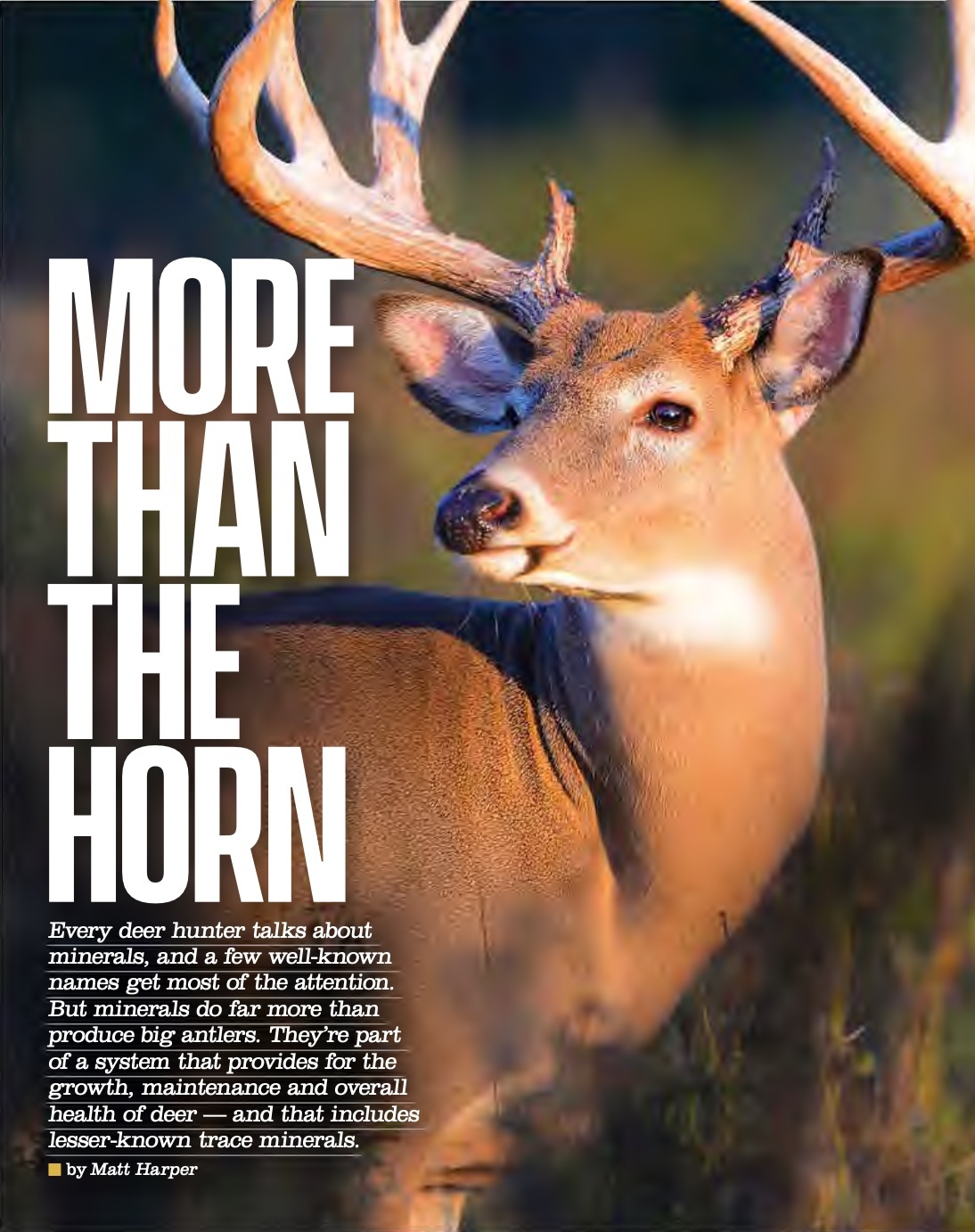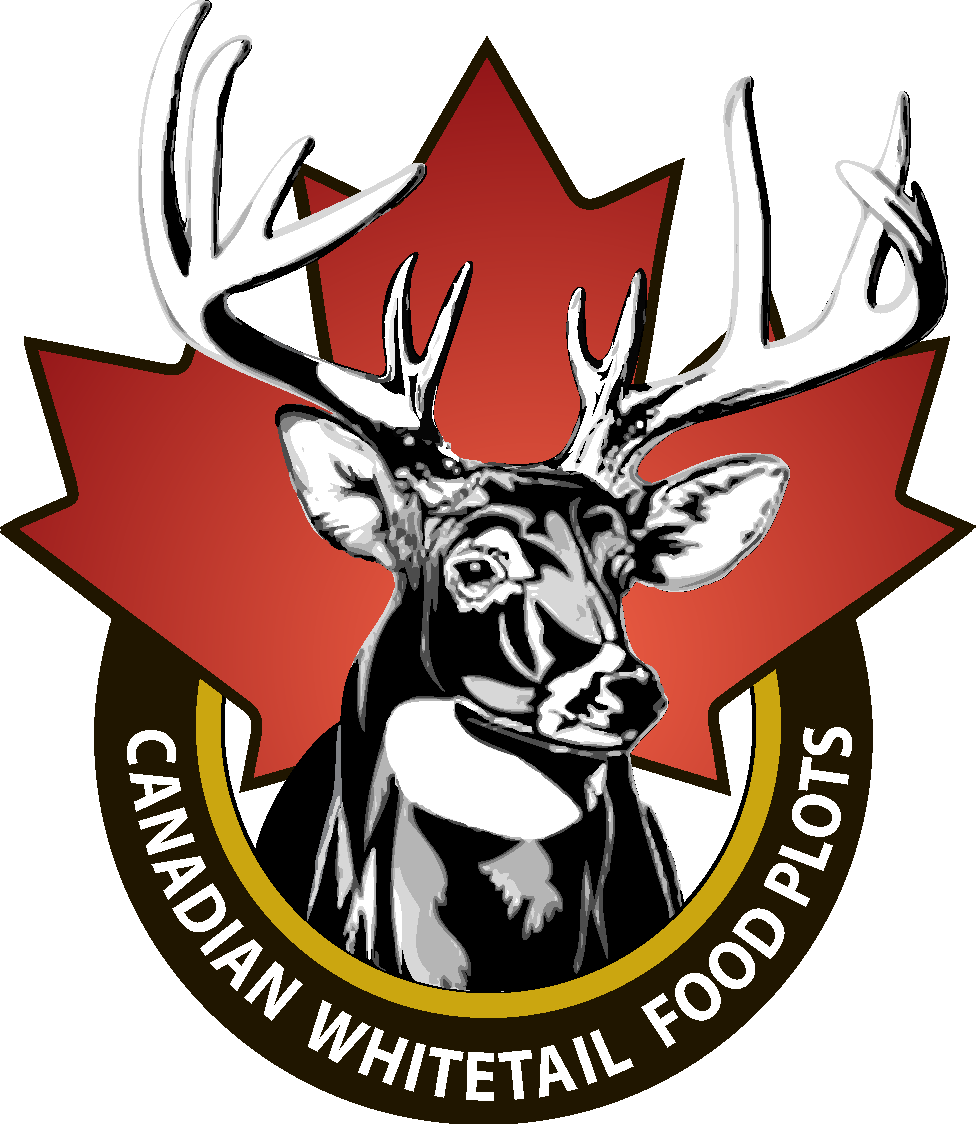MORE THAN THE HORN

The title of this piece might make you believe it’s one of those it’s-not-all-about -the-antlers articles, in which the author espouses the more subtle rewards of deer hunting instead of heavy bone.
I agree that the joy of deer hunting is comprised of hundreds of little things, not simply the goal of another adornment on the wall. Learning the subtleties and nuances of the hunt, management and preparation, the opportunity to enjoy the daily performance of nature and, of course, filling the freezer with good meat are among the reasons we get excited when fall approaches. But let’s be honest: Most of us will not pass a gnarly old buck when he walks down a trail where we’re perched. At varying degrees, all deer hunters fixate on antlers and look forward to the moment when a huge buck walks into our lives.
It is no wonder that when the subject of minerals arises, the immediate correlation is to bone on a buck’s head. After all, it seems logical that mineral in the diet leads to antler growth, and that logic is accurate. But minerals do far more than simply fuel the development of antlers. They are involved in many complex and vital functions in the metabolic and biologic activities of a deer. Because antlers are somewhat of a gauge of the overall health and condition of a buck, you could say most mineral functions affect antler growth. But they don’t do that entirely in the manner you might believe. Rather, they’re a part of system that collectively provides for the growth, maintenance and overall health of the animal. Minerals are more than the horn.
Types and Interaction
It’s difficult to tackle this subject because it quickly gets technical, and truthfully, minerals are involved in so many bodily functions that you could fill a small library with books on the subject. It’s not my goal to have your eyes glaze over while reading a thesis paper on minerals, so I’ll hit some of the high points of mineral functions, focusing on lesser publicized trace mineral components.
Minerals are divided into two main categories: macro minerals and trace minerals. Macro minerals are those animals need in large quantities in their diet for proper function and health. Examples include calcium, phosphorus, magnesium, potassium and sodium. These elements usually garner most of the limelight in mineral discussions because of the prominence they have in the antler growing process — as they should, as calcium, phosphorus and magnesium make up more than one-third of a hardened antler.
Trace minerals, on the other hand, are those animals need in comparably small amounts. But nonetheless, they’re vital for the overall health and well-being of a deer. In fact, when trace minerals and macro minerals are not in balance, interactions between them can negatively affect the functions of macro minerals. Think of the internal workings of a vehicle. You have big pieces, such as the engine and transmission, but there are hundreds of little pieces and parts that must correctly work together for the vehicle to run as it should. A small valve or wire, or some other minute part buried deep within the motor, can malfunction and bring the entire thing to a halt. There’s no hierarchy when it comes to mineral nutrition and, more specifically, to this discussion on trace mineral nutrition. Although requirement levels vary by trace minerals, deer need all of them in the correct amounts for the system to work.
Copper
Copper has been an important element for humans for thousands of years, as our ancestors crafted it into pots, jewelry, weapons and religious artifacts, and it’s a conductor of electricity. More recently, copper was found to be an important nutrient for many organisms. It has many functions in the body, one of which is its role as a co-factor in several oxidation-reduction enzyme systems. Copper is also involved in hemoglobin synthesis and the formation of connective tissues, such as tendons, ligaments and bones. It’s important in estrus expression as well as gestation maintenance, and is involved in immunity and immune response. A classic copper deficiency symptom is a change in hair color, as copper plays a major role in hair pigmentation. Copper deficiencies can also produce lameness, swelling of joints and a weak bone structure. In mineral supplements, copper can come in many forms, but the most common is copper sulfate. Some copper compounds, such as copper oxide, are extremely low in terms of digestibility.
Zinc
Although still formulated into a mineral at lower levels than macro minerals, zinc supplementation amounts are among the highest in trace minerals. Zinc plays a major role in immunity and immune functions within an animal. Studies with various ruminant and nonruminant species have shown improvement in mortality and morbidity rates, as zinc-supple-mented animals seem to have a higher health plane. Zinc is also important in reproduction, affecting the onset of sexual maturity, sperm count and viability, and ovulation and gestation. It also plays a role in several enzyme activities and is involved in bone growth and health. If zinc is deficient in the diet, it can sometimes be recognized by skin or hair coat abnormalities, but many symptoms are not necessarily overt. Zinc-deficient diets can result in reproductive issues, susceptibility to wound and disease problems, and a general decrease in body weight. Supplementing zinc in ruminants and nonruminants has been shown to increase body weights, and improve conception rates, hoof health and overall wellness. Common forms of zinc in mineral supplements include zinc sulfate and zinc oxide.
Manganese
Copper and zinc often overshadow manganese in discussions on trace mineral nutrition, but manganese is critical for many important functions. It’s a co-factor in enzyme activity for fat and carbohydrate metabolism, which affects energy production. Manganese is also involved in the formation of bone and connective tissue, as well as having antioxidant activities, which affect immune status and health. Additionally, manganese plays a role in reproduction, as deficiencies have been shown to produce testicle degeneration and defective ovulation. Other manganese deficiency symptoms include decreased growth and body weight, as well as joint and skeletal issues. Sources of manganese typically found in mineral supplements include manganese sulfate and manganous oxide.
Iron
The main role of iron in the body is cellular respiration through hemoglobin production. A lack of iron is commonly associated with anemia, which leads to general weakness and lethargy. Iron deficiencies are often most prevalent in younger animals, but they can also be found in older animals. Although the body needs iron, misformulation of iron leading to oversupplementation can cause problems, as iron tends to bind other minerals. Therefore, it’s extremely important to make sure the mineral supplement you’re using has been formulated appropriately and at exact levels. The most common iron source is iron sulfate, but iron oxide will often show up on a mineral tag. Iron oxide is essentially undigestible and is typically used for coloration of the product.
Cobalt
As a trace mineral, cobalt has one of the lowest requirement levels in the diet, but it’s still extremely valuable, especially in ruminants. Cobalt is a component of vitamin B12 and is needed by rumen microorganisms for growth and the production of vitamin B12. Vitamin B12 is essential for energy metabolism, so a deficiency in cobalt equals a deficiency in vitamin B12, which leads to loss of appetite, reduced growth and reduction in overall body weight. If the deficiency is bad enough, it can even cause death. Cobalt in minerals primarily comes from cobalt carbonate but can also be in the form of cobalt sulfate.
Iodine
Iodine is another trace mineral needed in very small amounts, but it can have a big impact on the performance of an animal. Iodine is used by the thyroid gland, which produces hormonal activity that affects metabolism and overall growth. Iodine also is involved in the reproductive system, and if it’s deficient, that can lead to stillborns or weak animals at birth. An inadequate amount of iodine in the diet can also lead to decreased growth and body weights. Iodine commonly comes in a couple of forms in a mineral supplement: calcium iodate or ethylenediamine dihydroiodide.
Selenium
All trace minerals can be toxic if fed to animals at too high of a level, but selenium has an extremely low threshold for toxicity. In other words, there’s a very small window between too little selenium and too much, which is why it’s regulated by the FDA in supplements and feed. Selenium-deficient soils can be found in many parts of the United States, and selenium supplementation in those areas have shown positive results. Selenium is involved in several enzyme activities. In particular, it’s a component of enzymes that inhibit peroxides that cause cell damage. Selenium works with vitamin E to protect cell membranes and cell walls, which is especially important in muscle tissue. A classic deficiency sign of selenium is muscle dystrophy, and it often results in a condition called white muscle disease. Sodium selenite is a common form of selenium in mineral supplements.
Summary
As you read through the functions and deficiency signs of trace minerals, you soon realize that trace minerals play a major role in many functions of a deer’s internal workings. A common theme with many trace minerals is the importance they play in immunity, health, metabolism, growth, body weight and reproduction. But the importance of trace minerals is not limited to those areas. Deer naturally get these minerals from the soil, as they are taken up by forages the deer consumes. But minerals are often less than adequate in many parts of the country. In fact, almost all soils are deficient in at least one or more minerals, including trace minerals. It’s important to note that it takes a severe deficiency to result in visible symptoms, and even if those symptoms are present, it’s difficult to determine the exact cause — such as in the case of lowered immune activity. Deer are simply more susceptible to infections and disease if certain trace minerals are too low in their diet, but most of us just see a sick deer. Also, a deer could have lower-than-optimal body weight caused by a trace mineral deficiency, but it might just look like a skinny deer.
So how do you know if trace mineral supplementation will have a positive effect? The best answer is that domestic ruminants in the same areas and regions are fed supplemental trace minerals, and because those animals can be checked and analyzed for variations in body weight, health status and reproductive efficiency, managers can show that trace mineral supplementation is beneficial. It’s only logical that deer would benefit in the same manner. Further, field studies using harvest-weight data in areas using mineral supplementation versus areas with none have shown improved body weights, higher fawn survivability and increased antler growth.
Just like the next guy, I get giddy when I see a big, mature buck sporting an impressive set of antlers. And if there’s something I can do to help bucks maximize their antler growing ability, I will do it. But I think it’s important to know that using good management practices can improve the nutritional well-being of deer as a whole, which leads to a more vibrant, healthy and productive herd. Of course, that also indirectly leads to bigger bucks.
